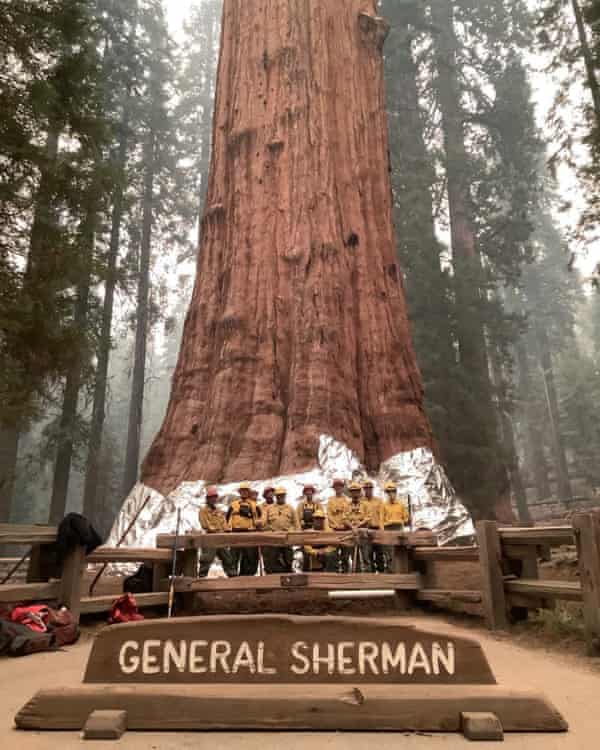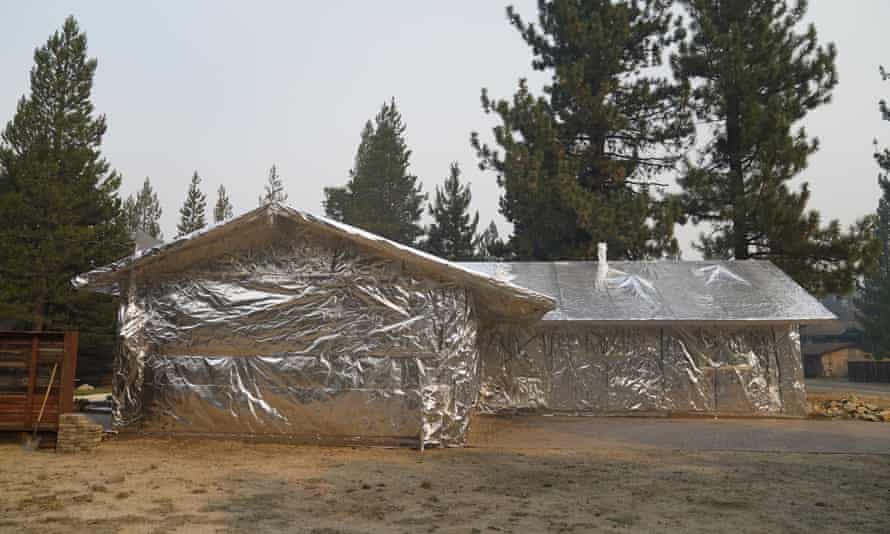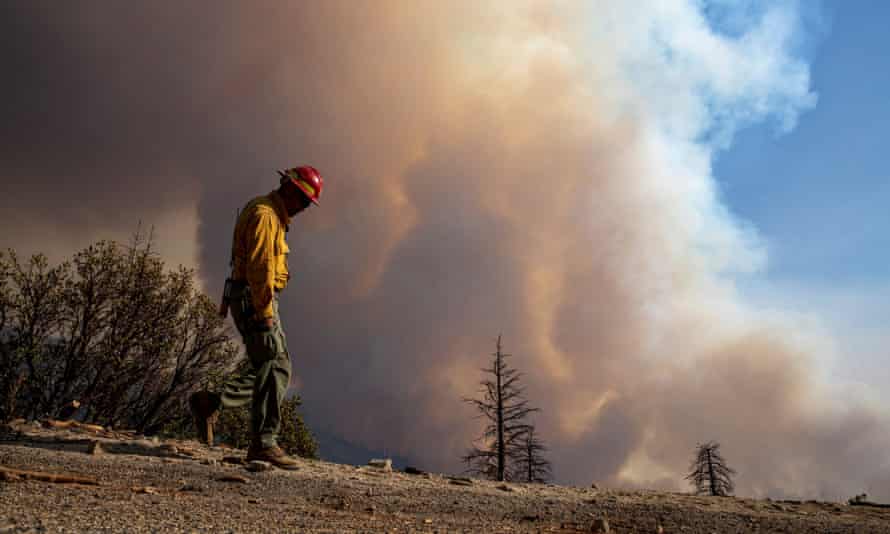California wildfires reach edge of sequoia grove containing world’s largest tree
Firefighters were temporarily driven away as two blazes merged and made a run to the edge of the Giant Forest in Sequoia national park
Two lightning-sparked wildfires in California have merged and made a run to the edge of a grove of ancient sequoias, briefly driving away firefighters as they tried to protect the world’s largest tree by wrapping its base in protective foil.
A shift in the weather fanned flames in the Sequoia national park in the Sierra Nevada on Friday, the National Park Service said. The flames reached the westernmost tip of the Giant Forest, where it scorched a grouping of sequoias known as the Four Guardsmen, which mark the entrance to the grove of 2,000 sequoias.
Firefighters wrapped the base of the General Sherman Tree in fire-resistant aluminum of the type used in wildland firefighter emergency shelters and to protect historic wooden buildings. It wasn’t immediately known how the Four Guardsmen, which received the same treatment, fared, fire spokeswoman Katy Hooper said.

The General Sherman Tree is the largest in the world by volume, at 52,508 cubic ft, (1486 cubic m) according to the National Park Service. It is 275ft (83m) high and has a circumference of 103ft (31m) at ground level.
Some Californians are choosing to wrap their homes in the fire-resistant aluminum. One wrapped home near Lake Tahoe survived the Caldor fire while neighboring houses were destroyed.
The wrapping deflects heat, helping prevent flammable materials from combusting. It also keeps airborne embers, a major contributor to spreading wildfires, from slipping through vents and other openings. With a fiberglass backing and acrylic adhesive, the wraps can withstand heat of up to 1,022 F, or 550C.
The current fires are eating through tinder-dry timber, grass and brush. Historic drought tied to climate change is making wildfires harder to fight. It has killed millions of trees in California alone. Scientists say climate change has made the west much warmer and drier in the past 30 years and will continue to make weather more extreme and wildfires more frequent and destructive.
More than 7,000 wildfires in California this year have damaged or destroyed more than 3,000 homes and other buildings and torched well over 3,000 square miles of land, according to the California Department of Forestry and Fire Protection.
The fires threatening the Giant Forest, known together as the KNP Complex, have blackened 28 square miles (72 square kilometres) of forest land.
Fire activity increased Friday afternoon when winds picked up and low-hanging smoke that had choked off air and limited the fire’s growth in recent days lifted, Hooper said.
Firefighters who were wrapping the base of the sequoias in foil and sweeping leaves and needles from the forest floor around the trees had to flee, but returned on Saturday when conditions improved to continue the work and start a strategic fire along Generals Highway to protect the Giant Forest grove, Hooper said.
The fires forced the evacuation of the park and parts of Three Rivers, a community of about 2,500 people outside the park’s main entrance. Crews have been bulldozing a line between the fire and the community.
Cooler, calmer weather and morning low-hanging smoke that choked off air limited the fire’s growth in recent days but the NWS said a low-pressure system will bring some gusty winds and lower humidity through Sunday in the fire area. However, fire officials weren’t expecting the kinds of explosive wind-driven growth that in recent months turned Sierra Nevada blazes into monsters that devoured hundreds of homes.

“There isn’t a lot of extreme weather predicted for the next few days, which is good news, there’s not a lot of big wind shifts predicted. However, there’s also no rain predicted,” fire information spokeswoman Rebecca Paterson said. “So we’re anticipating that the fires are going to continue to grow. Hopefully they’re not going to grow too fast.”
Giant sequoias are adapted to fire, which can help them thrive by releasing seeds from their cones and creating clearings that allow young sequoias to grow. But the extraordinary intensity of fires – fueled by climate change – can overwhelm the trees.
The fires have burned into several groves containing trees as tall as 200ft and 2,000 years old. They include Oriole Lake grove in the national park and Peyrone North and South groves in the neighboring Sequoia national forest.
The fire had reached Long Meadow grove in the national forest, where two decades ago Bill Clinton signed a proclamation establishing a national monument.
“These groves are just as impressive and just as ecologically important to the forest,” Tim Borden, who is sequoia restoration and stewardship manager for the Save the Redwoods League, told the Bay Area News Group. “They just aren’t as well known. My heart sinks when I think about it.”

To the south, the Windy fire grew to nearly 11 square miles on the Tule River Indian Reservation and in Giant Sequoia national monument, where it has burned into one grove of sequoias and threatens others.
Fire officials haven’t yet been able to determine how much damage was done to the groves, which are in remote and hard-to-reach areas.
Last year, the Castle fire killed an estimated 7,500 to 10,600 large sequoias, according to the National Park Service. That was an estimated 10% to 14% of all the sequoias in the world.